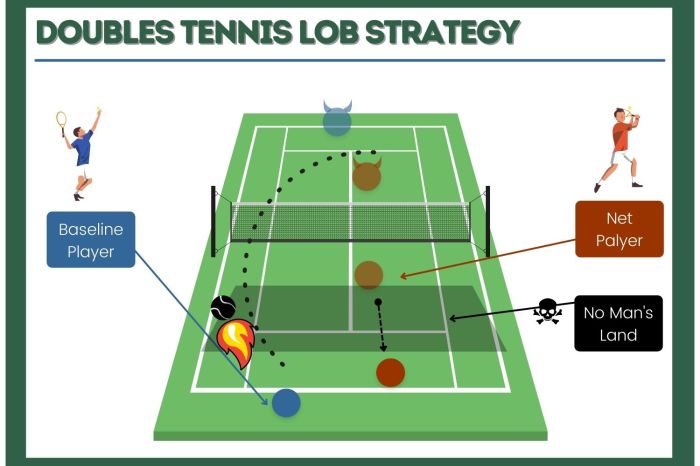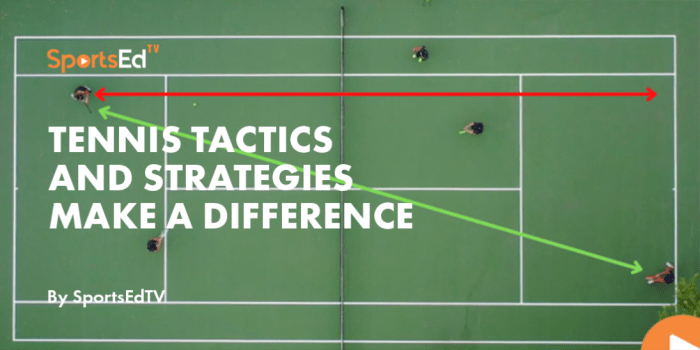Tennis strategies are like the secret sauce to dominating the court – whether you’re unleashing killer serves or outsmarting your opponent with clever plays, it’s all about having the right game plan. Strap in as we dive deep into the world of tennis strategies that will take your game to the next level.
Overview of Tennis Strategies
Having a well-thought-out strategy in tennis is crucial for success on the court. It involves analyzing your opponent’s weaknesses, exploiting your strengths, and adapting your game plan as needed during a match.
Variability of Tennis Strategies
Tennis strategies can vary greatly depending on a player’s strengths and weaknesses. For example, a player with a powerful serve may choose to focus on holding serve consistently, while a player with great speed and agility may prefer to play a defensive baseline game.
Role of Mental Tactics
- Visualization: Visualizing successful shots and outcomes can help players stay focused and confident during matches.
- Positive Self-talk: Encouraging oneself and maintaining a positive mindset can boost performance and resilience on the court.
- Adaptability: Being able to adjust strategies on the fly based on the opponent’s game can be a game-changer in tight matches.
Offensive Strategies

When it comes to offensive strategies in tennis, players have a variety of options to choose from to gain the upper hand on the court. By being proactive and taking control of the point, players can put pressure on their opponent and force them to make mistakes.
Aggressive Baseline Play
- Aggressive baseline play involves staying close to the baseline and hitting powerful groundstrokes to keep the opponent on the defensive.
- Players who excel in aggressive baseline play often have strong forehands and backhands, allowing them to dictate the pace of the game.
- By constantly applying pressure with deep, fast shots, players can force errors from their opponents and create opportunities to finish points at the net.
Approaching the Net
- Approaching the net is another effective offensive strategy that involves moving towards the net to hit volleys or overheads.
- Players who are skilled at approaching the net can take advantage of short balls or weak returns to put away easy winners.
- By coming to the net, players can cut off angles and limit their opponent’s options, forcing them to come up with difficult passing shots.
Exploiting Opponent’s Weaknesses
- One key aspect of offensive strategies is identifying and exploiting the weaknesses of your opponent.
- Whether it’s a weaker backhand or a tendency to struggle with high balls, players can target these areas to gain an advantage in the match.
- By consistently attacking their opponent’s weaknesses, players can keep them off balance and control the flow of the game.
Importance of Shot Selection
- Shot selection plays a crucial role in executing offensive strategies effectively.
- Choosing the right shot at the right moment can determine the outcome of a point, especially when under pressure.
- Players must consider factors such as court position, opponent’s position, and their own strengths when deciding which shot to play.
Defensive Strategies: Tennis Strategies

When it comes to tennis, having strong defensive strategies can make all the difference in a match. These strategies are crucial for players looking to neutralize their opponent’s strengths and turn the tide in their favor. Let’s dive into some key defensive tactics that players can use to up their game.
Retrieving Balls
One of the fundamental defensive strategies in tennis is retrieving balls effectively. This involves moving quickly to reach shots that are difficult to return, using a combination of speed and agility to get to the ball and keep it in play. Players must anticipate their opponent’s shots and position themselves strategically to retrieve balls successfully.
Counterpunching
Counterpunching is another important defensive strategy in tennis, where players turn their opponent’s aggressive shots into opportunities for themselves. By absorbing and redirecting the pace and power of their opponent’s shots, players can disrupt their rhythm and gain control of the point. This requires excellent timing, precision, and the ability to read the game effectively.
Defensive Lobs
Defensive lobs are a valuable tool for players facing aggressive opponents who like to approach the net. By hitting a well-executed defensive lob, players can push their opponent back and buy themselves more time to recover and reset the point. This strategic shot can force the opponent to retreat and disrupt their attacking game plan.
Significance of Footwork and Positioning
In implementing defensive strategies successfully, footwork and positioning play a crucial role. Good footwork allows players to move quickly and efficiently around the court, enabling them to reach difficult shots and maintain balance during rallies. Proper positioning helps players anticipate their opponent’s shots, react effectively, and set up their own defensive or counterattacking shots.
Serving Strategies
When it comes to serving in tennis, players have a variety of strategies at their disposal to gain an advantage over their opponents. Serving is not just about getting the ball in play; it can be a powerful weapon to dictate the pace of the game and keep your opponent on their toes.
Players can choose between power serving and placement serving. Power serving involves hitting the ball with maximum speed and force, aiming for aces or unreturnable shots. On the other hand, placement serving focuses on accuracy and precision, strategically placing the ball in difficult spots for the opponent to return effectively.
Varying Serves, Tennis strategies
Varying serves is crucial to keep the opponent off balance and prevent them from anticipating your shots. By mixing up the speed, placement, and spin of your serves, you can keep your opponent guessing and unable to settle into a rhythm. This can lead to more unforced errors from your opponent and give you the upper hand in the match.
It’s important for players to practice different types of serves during training sessions to master the art of varying serves effectively during a match. By continuously challenging your opponent with different serves, you can control the tempo of the game and maintain the element of surprise throughout the match.

